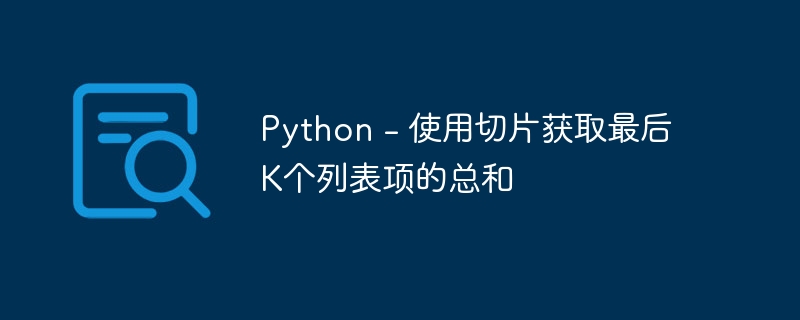Python - 使用切片获取最后K个列表项的总和

在Python中,切片方法允许我们从序列(如字符串、列表或元组)中提取特定元素。它提供了一种简洁灵活的方式来处理较大序列中的子序列。在本文中,我们将探讨如何使用切片操作获取列表中最后K个元素的和。
算法
To find the sum of the last K items in a list, we can follow a simple algorithm:
接受列表和K的值作为输入。
使用切片操作符从列表中提取最后K个项目。
计算提取项目的总和。
Return the sum as the output.
语法
sequence[start:end:step]
在这里,slice方法接受三个可选参数:
start (optional): The index of the element where the slice should start. If not provided, it defaults to the beginning of the sequence.
end(可选):切片应该结束的元素的索引(不包括)。如果未提供,则默认为序列的末尾。
step (optional): The step or increment value for selecting elements. If not provided, it defaults to 1.
The start, end and step values can be positive or negative integers, allowing you to traverse the sequence in both forward and backward directions.
示例1:使用切片方法求最后K个项目的总和
通过在切片中指定负索引,我们可以从列表的末尾开始向后遍历。以下是使用切片获取最后K个列表项的总和的语法:
In the below example, we have a list my_list containing 10 elements. We want to find the sum of the last 4 items in the list. By using the slice operator [-K:], we specify the range from the fourth−to−last element to the end of the list. The sum() function then calculates the sum of the extracted elements, resulting in 280.
my_list = [10, 20, 30, 40, 50, 60, 70, 80, 90, 100]
K = 4
sum_of_last_k = sum(my_list[-K:])
print("Sum of last", K, "items:", sum_of_last_k)
输出
Sum of last 4 items: 340
示例2:使用集合模块中的tail函数
来自collections模块的tail函数是一种方便的方法,用于从序列中提取最后N个元素。它允许您避免使用负索引进行切片。
在下面的示例中,我们从collections模块导入deque类,并将所需的最大长度(maxlen)指定为N。通过将numbers列表和maxlen=N传递给deque,我们创建一个仅保留最后N个元素的deque对象。使用list(tail_elements)将deque对象转换为列表,可以获得尾部元素[6, 7, 8, 9, 10]。
from collections import deque numbers = [1, 2, 3, 4, 5, 6, 7, 8, 9, 10] N = 5 tail_elements = deque(numbers, maxlen=N) print(list(tail_elements))
输出
[6, 7, 8, 9, 10]
Example 3: Using the islice function from the itertools module
The islice function from the itertools module allows you to extract a specific subsequence from an iterable, such as a list or string, by providing the start, stop, and step values.
In the below example, we import the islice function from the itertools module. By passing the numbers list along with the start, stop, and step values to islice(numbers, start, stop, step), we extract the desired subsequence [6, 8, 10]. Converting the result to a list using list(islice(...)) enables us to print the subsequence
from itertools import islice numbers = [1, 2, 3, 4, 5, 6, 7, 8, 9, 10] start = 5 stop = 10 step = 2 subsequence = list(islice(numbers, start, stop, step)) print(subsequence)
输出
[6, 8, 10]
Conclusion
在本文中,我们讨论了如何使用切片方法来获取最后k个项目的总和。切片方法提供了一种简洁高效的方式来执行此类计算,并使得获取列表最后k个项目的总和变得容易。切片方法还可以用于其他目的,如提取子序列,跳过具有步长值的元素,反转序列,获取最后k个元素等。
以上是Python - 使用切片获取最后K个列表项的总和的详细内容。更多信息请关注PHP中文网其他相关文章!

热AI工具

Undresser.AI Undress
人工智能驱动的应用程序,用于创建逼真的裸体照片

AI Clothes Remover
用于从照片中去除衣服的在线人工智能工具。

Undress AI Tool
免费脱衣服图片

Clothoff.io
AI脱衣机

Video Face Swap
使用我们完全免费的人工智能换脸工具轻松在任何视频中换脸!

热门文章

热工具

记事本++7.3.1
好用且免费的代码编辑器

SublimeText3汉化版
中文版,非常好用

禅工作室 13.0.1
功能强大的PHP集成开发环境

Dreamweaver CS6
视觉化网页开发工具

SublimeText3 Mac版
神级代码编辑软件(SublimeText3)
 Python与C:学习曲线和易用性
Apr 19, 2025 am 12:20 AM
Python与C:学习曲线和易用性
Apr 19, 2025 am 12:20 AM
Python更易学且易用,C 则更强大但复杂。1.Python语法简洁,适合初学者,动态类型和自动内存管理使其易用,但可能导致运行时错误。2.C 提供低级控制和高级特性,适合高性能应用,但学习门槛高,需手动管理内存和类型安全。
 学习Python:2小时的每日学习是否足够?
Apr 18, 2025 am 12:22 AM
学习Python:2小时的每日学习是否足够?
Apr 18, 2025 am 12:22 AM
每天学习Python两个小时是否足够?这取决于你的目标和学习方法。1)制定清晰的学习计划,2)选择合适的学习资源和方法,3)动手实践和复习巩固,可以在这段时间内逐步掌握Python的基本知识和高级功能。
 Python vs.C:探索性能和效率
Apr 18, 2025 am 12:20 AM
Python vs.C:探索性能和效率
Apr 18, 2025 am 12:20 AM
Python在开发效率上优于C ,但C 在执行性能上更高。1.Python的简洁语法和丰富库提高开发效率。2.C 的编译型特性和硬件控制提升执行性能。选择时需根据项目需求权衡开发速度与执行效率。
 Python vs. C:了解关键差异
Apr 21, 2025 am 12:18 AM
Python vs. C:了解关键差异
Apr 21, 2025 am 12:18 AM
Python和C 各有优势,选择应基于项目需求。1)Python适合快速开发和数据处理,因其简洁语法和动态类型。2)C 适用于高性能和系统编程,因其静态类型和手动内存管理。
 Python标准库的哪一部分是:列表或数组?
Apr 27, 2025 am 12:03 AM
Python标准库的哪一部分是:列表或数组?
Apr 27, 2025 am 12:03 AM
pythonlistsarepartofthestAndArdLibrary,herilearRaysarenot.listsarebuilt-In,多功能,和Rused ForStoringCollections,而EasaraySaraySaraySaraysaraySaraySaraysaraySaraysarrayModuleandleandleandlesscommonlyusedDduetolimitedFunctionalityFunctionalityFunctionality。
 Python:自动化,脚本和任务管理
Apr 16, 2025 am 12:14 AM
Python:自动化,脚本和任务管理
Apr 16, 2025 am 12:14 AM
Python在自动化、脚本编写和任务管理中表现出色。1)自动化:通过标准库如os、shutil实现文件备份。2)脚本编写:使用psutil库监控系统资源。3)任务管理:利用schedule库调度任务。Python的易用性和丰富库支持使其在这些领域中成为首选工具。
 科学计算的Python:详细的外观
Apr 19, 2025 am 12:15 AM
科学计算的Python:详细的外观
Apr 19, 2025 am 12:15 AM
Python在科学计算中的应用包括数据分析、机器学习、数值模拟和可视化。1.Numpy提供高效的多维数组和数学函数。2.SciPy扩展Numpy功能,提供优化和线性代数工具。3.Pandas用于数据处理和分析。4.Matplotlib用于生成各种图表和可视化结果。
 Web开发的Python:关键应用程序
Apr 18, 2025 am 12:20 AM
Web开发的Python:关键应用程序
Apr 18, 2025 am 12:20 AM
Python在Web开发中的关键应用包括使用Django和Flask框架、API开发、数据分析与可视化、机器学习与AI、以及性能优化。1.Django和Flask框架:Django适合快速开发复杂应用,Flask适用于小型或高度自定义项目。2.API开发:使用Flask或DjangoRESTFramework构建RESTfulAPI。3.数据分析与可视化:利用Python处理数据并通过Web界面展示。4.机器学习与AI:Python用于构建智能Web应用。5.性能优化:通过异步编程、缓存和代码优






